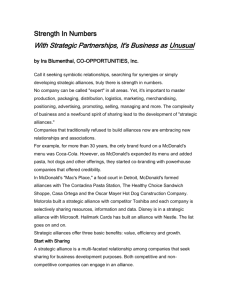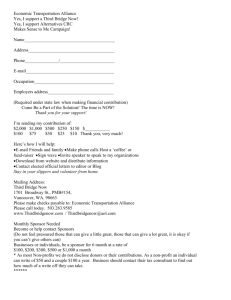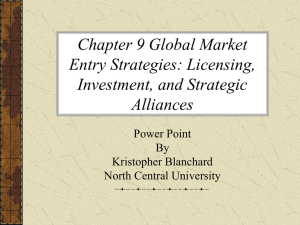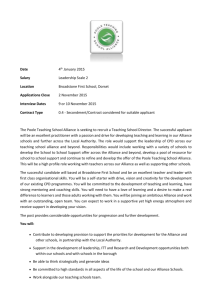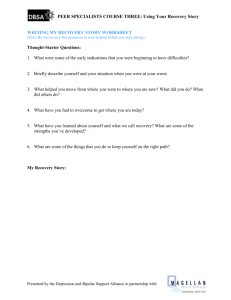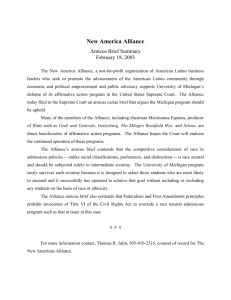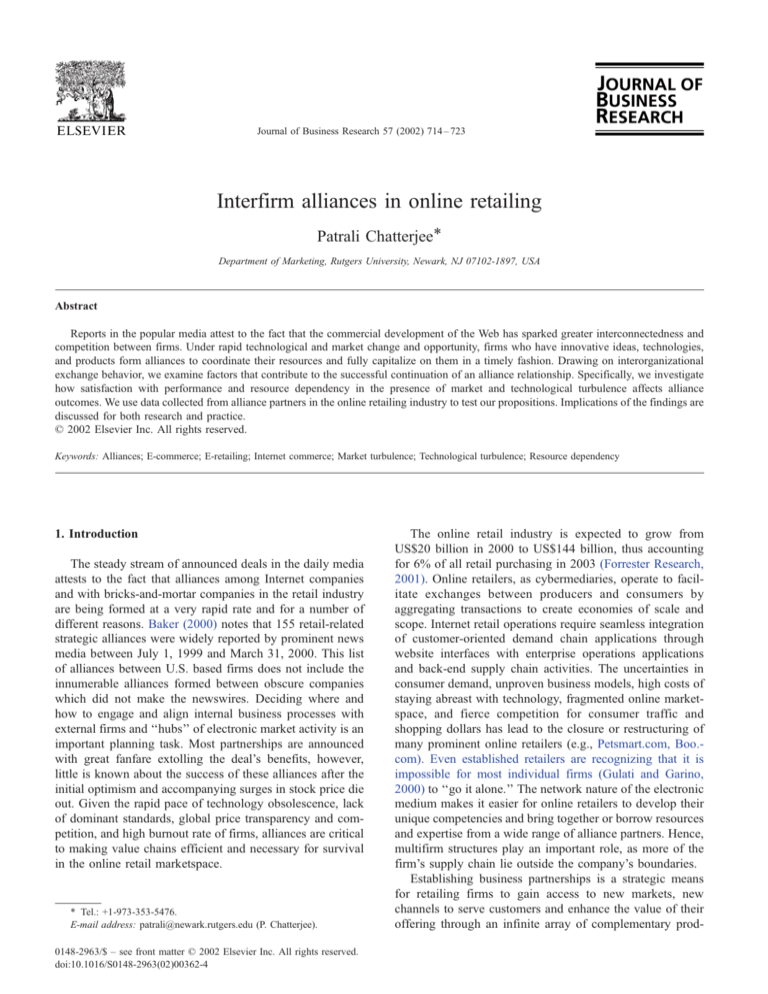
Journal of Business Research 57 (2002) 714 – 723
Interfirm alliances in online retailing
Patrali Chatterjee*
Department of Marketing, Rutgers University, Newark, NJ 07102-1897, USA
Abstract
Reports in the popular media attest to the fact that the commercial development of the Web has sparked greater interconnectedness and
competition between firms. Under rapid technological and market change and opportunity, firms who have innovative ideas, technologies,
and products form alliances to coordinate their resources and fully capitalize on them in a timely fashion. Drawing on interorganizational
exchange behavior, we examine factors that contribute to the successful continuation of an alliance relationship. Specifically, we investigate
how satisfaction with performance and resource dependency in the presence of market and technological turbulence affects alliance
outcomes. We use data collected from alliance partners in the online retailing industry to test our propositions. Implications of the findings are
discussed for both research and practice.
D 2002 Elsevier Inc. All rights reserved.
Keywords: Alliances; E-commerce; E-retailing; Internet commerce; Market turbulence; Technological turbulence; Resource dependency
1. Introduction
The steady stream of announced deals in the daily media
attests to the fact that alliances among Internet companies
and with bricks-and-mortar companies in the retail industry
are being formed at a very rapid rate and for a number of
different reasons. Baker (2000) notes that 155 retail-related
strategic alliances were widely reported by prominent news
media between July 1, 1999 and March 31, 2000. This list
of alliances between U.S. based firms does not include the
innumerable alliances formed between obscure companies
which did not make the newswires. Deciding where and
how to engage and align internal business processes with
external firms and ‘‘hubs’’ of electronic market activity is an
important planning task. Most partnerships are announced
with great fanfare extolling the deal’s benefits, however,
little is known about the success of these alliances after the
initial optimism and accompanying surges in stock price die
out. Given the rapid pace of technology obsolescence, lack
of dominant standards, global price transparency and competition, and high burnout rate of firms, alliances are critical
to making value chains efficient and necessary for survival
in the online retail marketspace.
* Tel.: +1-973-353-5476.
E-mail address: patrali@newark.rutgers.edu (P. Chatterjee).
0148-2963/$ – see front matter D 2002 Elsevier Inc. All rights reserved.
doi:10.1016/S0148-2963(02)00362-4
The online retail industry is expected to grow from
US$20 billion in 2000 to US$144 billion, thus accounting
for 6% of all retail purchasing in 2003 (Forrester Research,
2001). Online retailers, as cybermediaries, operate to facilitate exchanges between producers and consumers by
aggregating transactions to create economies of scale and
scope. Internet retail operations require seamless integration
of customer-oriented demand chain applications through
website interfaces with enterprise operations applications
and back-end supply chain activities. The uncertainties in
consumer demand, unproven business models, high costs of
staying abreast with technology, fragmented online marketspace, and fierce competition for consumer traffic and
shopping dollars has lead to the closure or restructuring of
many prominent online retailers (e.g., Petsmart.com, Boo.com). Even established retailers are recognizing that it is
impossible for most individual firms (Gulati and Garino,
2000) to ‘‘go it alone.’’ The network nature of the electronic
medium makes it easier for online retailers to develop their
unique competencies and bring together or borrow resources
and expertise from a wide range of alliance partners. Hence,
multifirm structures play an important role, as more of the
firm’s supply chain lie outside the company’s boundaries.
Establishing business partnerships is a strategic means
for retailing firms to gain access to new markets, new
channels to serve customers and enhance the value of their
offering through an infinite array of complementary prod-
P. Chatterjee / Journal of Business Research 57 (2004) 714–723
ucts and sophisticated value-added services without losing
autonomy and at lower levels of investment and risk.
Internet-related alliances in the retailing sector can be
categorized in terms of:
(i) alliances that deepen product, service, content, and
community offerings (Home and Garden TV –
Homeportfolio.com, Amazon.com – Drugstore.com
and Living.com),
(ii) give channel access to fulfillment capabilities (storebased Petco – Petopia.com),
(iii) give market access to partner’s customer bases
(Yahoo! – Kmart, AOL – Sears),
(iv) diversify revenue sources (Amazon and Greenlight.com, Imall–Nordstorm, Target), and
(v) give access to technology and marketing services
(couponing etc.) to improve functionality of retailer
website (Home Depot uses Lifeminders.com to send
‘‘how to’’ e-mail and Shaw’s supermarkets uses
Planetu.com to provide customized coupons).
These alliances represent a diverse array of transaction types,
levels of commitment, objectives, performance criteria,
creation of specific assets, and integration of operations.
Online-only firms have a number of advantages over
bricks-and-mortar businesses including established online
brand names and a mastering of technology needed to
contact customers at low cost. They may also have weaknesses in their ability to provide service and logistical
delivery components of the value chain. Without a physical
location for customers to touch, feel, and return products,
sales of some product categories may be limited. Similarly,
bricks-and-mortar stores that are able to leverage the Internet as an alternative selling channel can obtain advantages
over online-only sellers. For example, the Amazon.com –
Toys ’R’ Us alliance allows Toys ’R’ Us leverage the logistical, customer fulfillment expertise, and online market access
of Amazon.com while Amazon.com gains ToysRUs.com
buying experience, product assortment, physical stores to
handle returns, and bolster its weak toy product line.
Unlike vertically integrated mega-corporations and alliances studied in the literature, alliances in the e-commerce
sector are lateral relationships. They consist of corporate
allies who may be in entirely different industrial sectors but
whose products, services, and processes are virtually and
seamlessly integrated across organizational boundaries.
Most alliances in the e-commerce sector have emerged
out of a need to achieve critical mass to explore, the need
to be compatible with multiple standards in the short run,
and acquiring experience with the standard that becomes
dominant in the long run. This organizational form pools a
firm’s unique skills with the specialized resources of its
partners to create a more potent force with sufficient breadth
and sophistication to compete in the rapidly changing
market environment. Intellectual property and customer
intelligence assets rather than physical assets are primary
715
currency in online alliance relationships. Co-opetition is
developing as a new competitive model in which businesses
that are competitors in some areas cooperate with each other
in noncompetitive areas. Further alliances take the form of
constellations between multiple firms (e.g., alliance of 108
firms in developing Bluetooth technology) raising process
management demands to a very high level, leading to high
incidence of failures.
Marketing alliances in online retailing are a form of
working partnership defined by Anderson and Narus
(1990) as the ‘‘. . . mutual recognition and understanding
that the success of each firm depends in part on the other
firm . . ..’’ They are contractual relationships undertaken by
firms who perform complementary activities in facilitating
marketing exchanges. Unlike manufacturer – distributor
partnerships, marketing alliances are horizontal relationships between firms at the same level of the value-added
chain and represent a form of ‘‘symbiotic marketing’’
(Adler, 1966; Vardarajan and Rajaratnam, 1986). For
example, consider the alliance between DealTime.com, an
independent online comparison shopping service, and USAToday.com, a general interest news site on the Web (WSJ,
1999). It will expose 14 million unique monthly subscribers
to the cobranded version of DealTime.com service in the
USAToday.com’s Marketplace section. USAToday.com will
in turn, be able to enhance its service by offering DealTime.com’s patent-pending Desktop Notifier to provide
readers with time-sensitive notification of breaking news
headlines and hot deals.
We distinguish alliance relationships from retail affiliates
that are more visible on the Web. An affiliate or associate
program is an arrangement between a company and many
affiliate firms is characterized by unidirectional linking
with the purpose of generating traffic and transactions
similar to ‘‘instant access to salesforce of thousands.’’
The most popular examples are Amazon.com’s 260,000
associates and CDNow’s 145,000 affiliates. An affiliate
agrees to place information (usually a hyperlinked logo)
about its partner on its (i.e., affiliate) website; however,
there is no explicit reciprocal linking from the partner site
to the affiliate site. The affiliate gets a commission when a
visitor at its website uses a link to go to the partner site or
when the link results in a sale at the partner website. In
comparison to alliances that are collaborative relationships
(Day, 2000), affiliate relationships are short-lived and
transaction orientated with no commitment of joint success,
typically established or terminated with minimal effort and
investment. Typically, there are no exclusivity restrictions,
so an affiliate firm can offer links to several competing
firms. Partner firms offering affiliate programs benefit from
increases in sales and from image enhancement due to
broader exposure. For the affiliate site, being associated with the partner company may improve consumer’s
perceptions of the affiliate firm however the main incentive
is commission income accrued by delivering traffic or
sales referrals.
716
P. Chatterjee / Journal of Business Research 57 (2004) 714–723
The focus of investigation in this paper is on marketing
alliances in the online retailing industry. Equity-based
relationships, mergers, and joint ventures are not under
consideration. Strategically, alliances build on core competencies, strengthen research and technological capabilities,
accelerate the new product introduction process (Flanagan,
1993), and address asymmetries in the skill endowments of
firms (Hamel, 2000). Alliances also lead to a reduction of
risk and entry costs into new markets, higher capacity
utilization, and economies of scale (Flanagan, 1993).
Smaller firms may create alliances to survive and be
competitive with big competitors and incumbents.
Despite their potential benefits, marketing alliances pose
significant management challenges. While the necessary
condition for forming an alliance are predicated on the
notion that the alliance will provide a profit boost, a more
dynamic perspective is that the benefit/cost balance from an
alliance is not based on a one-time transaction, but is better
viewed as a continuous, repeated relationship over time till
one or both partners decide to leave the alliance. Research
indicates that marketing alliances alter investor valuation of
the firm (McConnell and Nantell, 1985) and consumer
valuation of the firm’s products (Mahajan and Venkatesh,
1996). However, increase in valuation due to an alliance
may not be equally beneficial to all partners and the
dominant role of one branded component can affect the
value of the partnering component. The potential for serious
conflict is always present as partners may compete with
each other in other product lines and, on occasion, in those
directly covered by the alliance agreement. The potential for
opportunism is high as partners may use the alliance only as
a means to gain market position at the expense of a partner
or to build technological skills from exposure to the part-
ner’s intellectual property unraveling even the most wellcrafted alliances. The imbalance in alliance outcomes leads
to dependence-balancing behaviors and opportunistic activities that ultimately lead to termination of the relationship
(Bucklin and Sengupta, 1993).
In keeping with our aim of studying factors influencing
survival of alliance relationships, we draw upon the interorganizational exchange behavior literature to formulate a
conceptual framework of anticipated marketing alliance
outcomes in terms of decision to continue in the alliance.
We investigate the effect of relative resource dependency,
uncertainty in market and technology environment on alliance outcome and define diagnostic measures. We then
report initial empirical data collected from key informants
within marketing alliances in the online retailing sector and
evaluate our results. We conclude with a discussion of
managerial implications of our findings.
2. Conceptual framework
Theoretical perspectives from transaction cost analysis
(Williamson, 1975) and interorganization exchange behavior
(Frazier, 1983; Pfeffer and Salancik, 1978) suggest that given
functional specialization and a scarcity of resources, organizations seek to reduce uncertainty by exchanging resources
in alliances for mutual economic gain. Since firms voluntarily form alliances to get access to resources owned by the
partner, the effect of resource dependency on the alliance
outcome is the focus of our investigation. The convergence of
information technology and telecommunications, increased
channel turbulence caused by the Internet, the embodiment of
information technology in new products has lead to creation
Fig. 1. Conceptual framework of factors affecting alliance outcomes.
P. Chatterjee / Journal of Business Research 57 (2004) 714–723
717
of new markets and changes in evaluating returns to investment, hence any research effort must consider the moderating
effect of environmental uncertainty (Fig. 1).
were characterized by expanding ambitions on the part of
partners and growing satisfaction with the firm’s gains from
the alliance. Hence, we propose,
2.1. Alliance outcomes
Hypothesis 2: Satisfaction with firm’s gains from the
alliance has a positive effect on intention to continue with
the alliance.
Research on alliances suggests that as partners engage in
the alliance and work together, each partner also engages in
an ongoing assessment on essentially two dimensions: outcome assessment and value appropriation (Hamel, 2000).
Each partner assesses the outcomes from the joint activities
as signals and clues about potential future value creation.
Several performance indicators of alliance success like
profitability, market share, investment in alliance, increase
in stock price, and consumer valuation of the alliance
offerings have been investigated in organization theory
(Van de Ven, 1976). However, many of these measures are
difficult to track quantitatively or allocate as results of an
alliance especially if a firm is involved in more than one
alliance typical of players in the online retail industry.
Further, typical of alliances in the online retail sector, partner
performance in terms of generating exposures to links (e.g.,
Yahoo! –Kmart), chat activity in online communities around
topics of interest to the firm (Healthion/WebMD – Gobel
Sports) is of importance rather than generating sales that
may be indirectly generated. Because alliance participants
perform complementary roles, a firm’s success depends on
its own performance and the performance of its partners.
Satisfaction with partner performance has been widely
recognized as an important influence on interfirm relationships (Hunt and Nevin, 1974) and would depend upon the
perceived contribution to the member’s performance outcomes (Frazier, 1983) and influences the member’s decision
to continue in the alliance. Hence, we propose:
Hypothesis 1: Satisfaction with the partner’s performance
has a positive effect on intention to continue with the
alliance.
Partners also assess how they will equitably share the
benefits from the alliance, presumably in proportion to their
contributions and efforts. In addition to the visible and
mutually expected set of outcomes and distribution of
benefits (tangible and intangible) identified in the explicit
agreement, there lie a series of other potential outcomes of
lesser or greater value to partners. Some of these benefits
may be discovered post hoc and may not be equally
available to each partner given differences in their capabilities and contributed skills. Furthermore, the partners may
not measure contributions and outcomes according to the
same yardstick, making mutual understanding difficult.
Perception of inequity in distribution of benefits is fraught
with suspicions of hidden agendas and leads to dissatisfaction with one’s realized or anticipated gains from the
alliance, in turn leading to lower commitment to the
alliance. Hamel (2000) observed that successful alliances
The relative strength of satisfaction with partner performance and gains from the alliance on the decision to continue
with the alliance deserves close investigation. Since attribution of the causes underlying the asymmetric distribution
of benefits are more likely to be perceived as more stable
(either as the partner’s hidden motives or the firm’s inherent
characteristics that prevent it from mitigating the inequity)
than a partner’s dissatisfactory performance. Further, most
firms in this industry are under pressure from their investors
and market analysts to demonstrate their viability as profitable enterprises, regardless of how their alliance partners
perform. Hence, we propose,
Hypothesis 3: In the online retailing industry, satisfaction
with firm’s gains from the alliance will have a stronger
effect on intention to continue with the alliance than
satisfaction with partner performance.
2.2. Resource dependence and impetus for alliance
One of the consequences of exchange among organizations is the emergence of resource dependencies among
partners. In the channels literature dependence refers to one
firm’s need to maintain a relationship with another firm in
order to achieve desired goals. The connection between
dependency and transaction cost analysis perspectives is
observed when the replaceability aspect of the resources and
partners is considered. Relative dependence is increased
when fewer alternative replacements to the incumbent
partner and resource are available (El-Ansary and Stern,
1972). A firm with greater relative dependence has, by
definition, relatively greater interest in sustaining the relationship to at least reap its own share of benefits in the short
term (Bucklin and Sengupta, 1993). Hence, we propose,
Hypothesis 4: Firms in the online retail industry that are
relatively more dependent on their partners are more likely
to continue with the alliance.
Adopting a resource-based approach, the strategic worth of
the resources gained through alliance relationships makes
firms more likely to continue in relationships when compatible partners are identified whose complementary resources, when combined with their own resources, provide
competitive advantages (Morgan and Hunt, 1999).
Motivation to stay in an alliance is stronger when the
resources that produce sustainable advantages cannot be
easily replaced through a purchase (e.g., online or offline
718
P. Chatterjee / Journal of Business Research 57 (2004) 714–723
fulfillment capabilities of a partner), are imperfectly mobile
(e.g., access to a partner’s consumer clickstream file may be
nondeployable by law for privacy concerns), and imperfectly imitable (e.g., copyrighted community and service
offerings of an online partner). Since most alliances apply to
more than one category, we empirical test that firms that
depend on their partners for product, market, and channel
access are more likely to continue with the alliance than
those who receive revenue and technological resources.
Hence, we propose,
Hypothesis 4a: Firms that primarily get market, product,
and channel access are more likely to be dependent on their
alliance partner than those who get revenue or marketing
services.
Firms that own operations in both the online and offline
markets typically termed ‘‘hybrids’’ will be less dependent
on their alliance partner for access to online and offline
consumers than those firms who only have online or offline
operations or ‘‘pure plays.’’ While hybrid firms do form
alliances to enhance their online and offline offerings they
are better positioned leverage the advantages offered by
both the channels than pure plays. Hence, we propose,
Hypothesis 4b: Firms that own both offline and online
operations will be relatively less dependent on their alliance
partner than pure play firms who own either an offline or
online channel.
2.3. Alliance involvement
Research in alliance capability suggests that firms learn
to manage interfirm relationships better as experience accumulates. Alliances involve a high degree of contractual
ambiguity and firms that enter into more alliances are able
to institutionalize alliance knowledge and benefit from
learning effects (Nuance, 1994). In an environment where
most companies, on average, face high alliance failure an
ability to manage alliances more effectively can itself
become a source of sustainable competitive advantage. A
large firm may have as many as 60 alliances over time,
hence skills of alliance partners in managing alliances is an
important success factor rather than characteristics of the
alliance. Hence, we propose,
Hypothesis 5: Firms that are involved in more alliance
relationships are more likely to continue in the alliance than
those involved in fewer alliances.
2.4. Market and technological turbulence
Market and technological dynamism have been shown to
be important in interorganizational relationships (Heide and
John, 1988). Technological turbulence refers to the degree
to which technology changes over time within the industry
and the degree to which such changes affect the industry.
Volatility due to the rapid emergence and obsolescence of
new technologies and standards for online security and
payment systems and watermarking technologies that online
retailers have to comply with require huge financial investments making it necessary for players to ally themselves.
Researchers have argued that alliances may be a more
effective organizational firm under conditions of high technological turbulence by making it possible to accelerate time
to market and gain access to complementary products or
technologies without all the risks of internal development (Bucklin and Sengupta, 1993; Jaworski and Kohli,
1993). Hence,
Hypothesis 6: Firms that perceive greater technological
turbulence affecting the online retailing industry are more
likely to continue in an alliance.
Market turbulence refers to the degree to which customer
preferences change over time resulting in new, previously
unknown, target segments emerging with greater impact on
the market (Jaworski and Kohli, 1993). Literature is equivocal on whether market turbulence enhances or detracts
relationships between firms. In fast-changing Web market
environment with unproven potential (typical of the online
marketplace), participating firms have a greater incentive to
coordinate their efforts to reduce uncertainty affecting their
own firm (Achrol et al., 1990) and the market. However, in
a contrary view, a firm operating on its own may be able to
respond rapidly to changes in consumer preferences with
changes in its product offerings, the another firm may be
slow to respond and can limit the flexibility. The process of
communication and joint-decision-making between alliance
partners may introduce delays and limit proactive measures
that a firm operating alone can take. Hence, we propose,
Hypothesis 7: Firms that perceive greater market turbulence
affecting the online retailing industry are less likely to
continue in an alliance.
Since alliances in the online retail industry are loose and
informal and do not involve exclusivity or proprietary
arrangements (e.g., Netscape and its alliance partners providing plug-in technologies), collaborative exchanges featuring very close information, social, and process linkages,
and mutual commitments must be made in expectation of
long-run benefits (Day, 2000). While both parties can seek
partners elsewhere, they may fail to capitalize on a market
opportunity in the short window available in Internet time.
Hence, the potential of the alliance to leverage opportunities
for gains in the future rather than project payoff in the near
term may be the deciding factor in continuing the relationship thus moderating the effect of relative resource dependency on alliance success. In an environment rife with rapid
changes in technologies and market conditions, a commanding position in an alliance relationship does not guarantee
satisfactory returns, making the stronger partner more willing to comprise with its weaker alliance partner. A firm with
P. Chatterjee / Journal of Business Research 57 (2004) 714–723
higher relative dependence has a higher motivation to stay
in the alliance, but is in a better situation to rely on the
goodwill of its partner to request response to changes that it
believes will either mutually increase the outcomes of both
partners or singly increase its own outcomes from the
relationship (Anderson and Narus, 1990). Hence,
Hypotheses 8a and 8b: The effect of resource dependency
on intention to continue in an alliance would be lower for
firms that perceive greater (a) market turbulence and (b)
technological turbulence.
3. Research methodology
3.1. Research setting
We selected firms within the online retailing sector as the
research setting for our study. Several features of this setting
make it appropriate for our investigation. First, strategic
alliances between firms in the online retailing sector have
been widely reported since 1995 (Internet Retailing Report,
1995). Most of these alliances have now gone beyond the
point of mere news value and publicity events to offer
credible and operational data for this research. Second, while
most e-commerce ventures have not yet demonstrated profits, firms in the retailing sectors have been ramping in
revenue and are under more pressure to demonstrate economic viability. Sample was limited to firms in a single
industry to maintain homogeneity. Third, we include Internet malls and not just individual retailers in our study in
anticipation of the wide range of alliances that can exist. An
Internet mall or cybermall is a collection of online retail
storefronts assembled in one electronic domain, either physically or through links. The alliance context examined in this
study is quite different from those studied in the past because
the Internet mall environment reflects a wide variety of
dependence levels between partners. For example, online
malls or retailers offer certain customer service features
(e.g., shopping cart technology or product shipping function) or product lines at their website for which there are
multiple vendors and others (e.g., payment and certification
technology) for which they are highly dependent on their
719
vendors. Alliance partners differ in size, reputation, financial
strength, and may be own suppliers, other retailers (in same
or complementary product categories), hardware, site hosting and application software providers, payment processors,
advertising, and product delivery (http://www.econgo.com/
partners.esl offers one such example). Fourth, contractual
agreements are typically short or open-ended, allowing firms
more flexibility to terminate their relationship.
The research design was unique in that both partners in
an alliance were studied. Because the Internet mall is the
unit of analysis, malls were selected from lists dynamically
generated or maintained at Cyberatlas, E-marketer, or
Yahoo! websites. To reduce the incidence of non-operational
sites, we selected only those that were listed in all three lists
(589 malls). We made initial contact by e-mail to solicit
participation in the study, identify key informant within the
organization (either owners or those with significant financial responsibility to reduce informant bias), and obtain
information on their alliance partner firms (who met set
criteria to avoid joint venture, merger, subsidiary firms from
being counted as alliance partners). A total of 47 Internet
malls agreed to participate in the study, however 11 firms
had to be dropped because they did not have any alliance
partners. We identified a total of 3167 alliance partner pairs
and contacted each partner separately for participation in the
study. Respondents were asked to complete an extensive
questionnaire that focused on their relationship and were
assured of complete anonymity and confidentiality, however
we had to assign codes for each pair to match replies. Due to
the length of the questionnaire, we restricted each respondent to answering only one questionnaire for a single designated partner although they could have answered for their
other partners. We correlated responses offered by both
members of each pair to detect cases where partners may
have colluded in answering the questionnaire, but did not
find any. After all questionnaires were returned, we had
usable data on 446 firms.
3.2. Measures
A brief description of measures used in the study
follows:
Construct
Item
Number of items
Decision to stay in the alliance
(STAY)
Relative dependence (DEPEND)
(Anderson and Narus, 1990),
Cronbach’s alpha=.68
1. We intend to continue with the alliance in the
next period.
1. Our alliance partner exerts ___ influence over
the way our firm advertises/distributes/markets/
promotes our products.
2. There are other firms available to our alliance
partner who can provide resources comparable to
those we provide.
3. There are others firms available to us who can
provide us resources comparable to those provided by our alliance partner.
1. We require that our alliance partners sign
exclusivity agreements with us.
1 (five-point scale)
Exclusivity restrictions (EXCLU),
Cronbach’s alpha=.55
3 (five-point scale)
2
720
Satisfaction with partner
performance (SATISPARTNER)
Satisfaction with own gains
(SATISOWN)
Technological turbulence (TTURB)
(Jaworski and Kohli, 1993),
Cronbach’s alpha=.76
Market turbulence (MTURB)
(Jaworski and Kohli, 1993),
Cronbach’s alpha=.64
Impetus for alliance (CBASE,
MERGEOFFER, FULFILLMT,
REVENUE, TECH)
Involvement in other alliances
(OTHER)
Channels owned (B&M, CL)
P. Chatterjee / Journal of Business Research 57 (2004) 714–723
2. Our alliance partner requires us to sign an
exclusivity agreement with them.
1. We are satisfied with our alliance partner’s
performance.
1. We are satisfied with our share of financial and
nonfinancial gains in relation to our contributions
in this alliance.
1. The technology in our industry is changing
rapidly.
2. Technological changes offer big opportunities
in our industry.
3. It is very difficult to forecast where the
technology in our industry will be in the next 2
to 3 years
4. A large number of product ideas and business
models have been made possible through technological breakthroughs in our industry.
5. Technological developments in our industry are
rather minor.
1. In the online retail industry, customer preference changes quite a bit over time.
2. Our customers tend to look for new products all
the time.
3. We are witnessing a demand for our products
and services from customers who have never
bought them before.
4. New customers tend to have product-related
needs that are different from those of our existing
customers.
5. We cater to many of the same customers that
we used to in the past.
1. This alliance gives us (a dot.com/physical) firm
access to fulfillment capabilities of our partner
(physical/dot.com) firm.
1. We are involved in ___ number of alliances at
this time.
1. We have only bricks-and-mortar channels.
2. We have Internet-based channels.
We did not use a binary measure for ‘‘decision to stay in the
alliance’’ (STAY) because pretest of our questionnaire indicated that most respondents tended to answer in the positive
even if they were not certain of it.
3.2.1. Relative dependence (DEPEND)
Relative dependence (DEPEND) was measured with a
three-item scale based on replaceability. Respondents
answered on a five-point scale ranging from prohibitive to
negligible. Binary responses were recorded if respondents
answered they were subject to an exclusive arrangement
with their partner (EXCLUOWN = 1) or if they required
their partner to sign an exclusive agreement (EXCLUPARTNER = 1).
3.2.2. Satisfaction with own (partner) performance goals
(SATISOWN, SATISPARTNER)
For both these measures, respondents were asked to mark
a point on a line anchored from by words poor (1) and
excellent (5) that best expressed their level of overall
satisaction with their own (SATISOWN) or alliance partner
(SATISPARTNER) performance goals. The midpoint on the
1 (five-point scale)
1 (five-point scale)
5 (five-point scale)
5 (five-point scale)
1 (binary) for
each variable
1 (count)
1 (binary)
line corresponds to satisfactory performance. The question
was purposefully not anchored to any comparison so that
respondents would be free to use whatever standard (for
example, profit, growth in revenues or traffic, experience)
they felt was appropriate.
3.2.3. Perception of technological and market turbulence
(TTURB, MTURB)
Items for both these measures were motivated from the
literature (Jaworski and Kohli, 1993). For both these measures, respondents were asked to mark a point on a line
anchored by words too many uncertainties (1) and no
uncertainties (5) that best expressed their perception of
technological turbulence (TTURB) and market turbulence
(MTURB).
3.2.4. Impetus for alliance (MERGEOFFER, FULFILLMT,
CBASE, REVENUE, TECH)
Binary responses were recorded based on the firm’s
perception of primary reason for forming the alliance. If
the alliance give a dot.com firm access to fulfillment
capabilities of another dot.com firm or a physical firm or
P. Chatterjee / Journal of Business Research 57 (2004) 714–723
gave a physical firm access to an Internet outlet FULFILLMT = 1, else FULFILLMT = 0.
Table 2
Regression results: propensity to stay in alliance and resource dependency
Independent variable
3.2.5. Involvement in other alliances (OTHER)
Respondents were asked about the total number of
alliances their firm was involved in at the present time.
3.2.6. Channels owned (B&M, CL)
Binary responses were noted for two variables if respondents had both online and offline operations, B&M = 1,
CL = 1; only bricks-and-mortar operation, B&M = 1,
CL = 0; or only online operation, B&M = 0, CL = 1.
In addition, experience in the retail industry, retail
formats used, information on annual sales revenues, traffic,
length of contract, future performance expectations, investment in, and length of their alliance partnership were
collected.
3.3. Analyses and results
Table 1 presents descriptive statistics about respondents
considered in this study. Our data indicate that the propensity to continue the alliance differ across firms in alliance
pairs, in 26% of alliances only one of the partners indicated
that they are likely to terminate the alliance (STAY:
1 = strongly disagree, 2 = somewhat disagree). Irrespective
of performance, both partners in 65% of alliance pairs
independently indicated that they wanted to continue with
the alliance.
Moderated regression analysis was used to test Hypotheses 1 –5. LISREL cannot be used for estimation because
it assumes the constructs are measured with reflective scales
(Bagozzi and Fornell, 1982). Since some of our constructs
are multidimensional and formative made operational as the
sum or difference of underlying unidimensional constructs,
they cannot be accommodated in a LISREL model. We
estimated two separate regressions for decision to continue
in an alliance and resource dependency, since the residuals
for both the equations were uncorrelated.
Table 1
Description of sample
Variables
Retailers
Internet
malls
Nonmerchant
partners
Total
Actual responses
STAY = 1
MTURB/TTURB = 1
MERGEOFFER = 1
FULFILLMT = 1
CBASE = 1 (%)
REVENUE = 1
TECH = 1
OTHER
(average number of
other alliance relations)
Publicly traded (%)
336
282
214
76
134
42
155
122
18
36
26
28
21
11
79
29
34
42
74
23
51
18
7
96
24
55
37
446
331
320
115
152
46
208
211
24
38
21
89
47
721
Standard
coefficients
t
values
Dependent variable: Intention to stay in the alliance (STAY,
Hypothesis 1: SATISPARTNER
.49
4.72
Hypothesis 2: SATISOWN
.29
2.94
Hypothesis 4: DEPEND
.25
2.41
Hypothesis 5: INVOLV
.18
1.99
Hypothesis 6: TTURB
.26
2.87
Hypothesis 7: MTURB
.13
1.72
Hypothesis 8a:
.23
2.22
TTURB DEPEND
Hypothesis 8b:
.21
2.11
MTURB DEPEND
Mean (S.D.)
R2=.39)
3.01 (1.923)
3.43 (1.024)
2.68 (1.34)
6.4 (4.9)
3.52 (1.231)
2.22 (1.46)
–
–
Dependent variable: Relative resource dependency (DEPEND, R2 = 0.22)
Hypothesis 4a: MERGEOFFER
.28
2.54
–
Hypothesis 4a: FULFILLMT
.46
4.13
–
Hypothesis 4a: CBASE
.18
1.54
–
Hypothesis 4a: REVENUE
.21
2.24
–
Hypothesis 4a: TECH
.19
2.08
–
Hypothesis 4b: B&M
.11
1.12
Hypothesis 4b: CL
.31
2.87
Coefficients in bold are significant at .01 level or higher.
In the alliance equation, intention to continue in alliance
was the dependent variable, while the main effects of
satisfaction with own gains and partner performance,
involvement in other alliances, relative dependence and
impetus for alliance, and the hypothesized moderator effects
of technological and market turbulence were the independent variables. Regression results are reported in Table 2.
Because all independent variables are standardized, each
variable’s coefficient provides a measure of its relative
importance. Hypothesis 2 predicted a positive relationship
between satisfaction with own gains from alliance on
intention to continue with the alliance and was supported
by data (b=.28, P < .05). Hypothesis 1 predicted a positive
relationship between satisfaction with partner’s performance
goals on intention to continue with the alliance and was
supported by data (b=.49, P < .01). These findings support
the notion that alliances succeed when firms are satisfied
with their own gains and partner firm performance. However, the hypothesized stronger effect of satisfaction with
own gains on intention to continue with alliance (compared
to satisfaction with partner performance) was significant in
the opposite direction. This unexpected result could be a
result of respondents only considering distribution of financial or tangible gains and not suspecting any inequity in
distribution of gains at this early stage of their alliance
relationships (average age of alliance was 2.2 years in this
sample). This may change as relationships evolve. An
alternate explanation is that regardless of pressures to
demonstrate profits, firms, and possibly their investors have
a long-term orientation to alliance relationships and are
willing to sacrifice immediate gains to be competitive in
the long run. The hypothesized positive effect of relative
resource dependency on intention to stay in the alliance
722
P. Chatterjee / Journal of Business Research 57 (2004) 714–723
(Hypothesis 4) was supported (b=.25, P < .05). Firms that
are involved in more alliance relationships are significantly
more likely to continue in an alliance, Hypothesis 5 is
supported. While the hypothesized positive effect of technological turbulence on intention to continue in an alliance
is supported (b=.26, P < .05, Hypothesis 6 supported), the
hypothesized negative effect of market turbulence (Hypothesis 7) is not. This finding may be explained by the fact
that unlike technological turbulence that is explicitly manifested through personal experience and media reports,
market turbulence, or change in consumer preferences is
more difficult to perceive and rarely identified.
Hypotheses 8a and 8b predicted that the degree of
perceived technological and market turbulence would moderate the effects of relative dependence on intention to
continue in an alliance. Both of these interaction terms are
statistically significant. The results indicate that technological (b = .26, P < .05) and market turbulence (b = .21,
P < .05) do moderate the effects of relative dependence on
intention to continue in an alliance. Thus, Hypotheses 8a and
8b are supported by the moderated regression results. In the
relative dependence equation, we find that pure click firms
are more dependent on their alliance partner than bricks-andmortar and hybrid firms, while this provides partial support
for our Hypothesis 4b for hybrid firms, we did not anticipate
this finding for pure brick-and-mortar firms. Pure brick-andmortar firms may not perceive themselves to be more
dependent on the alliance to gain access to the online channel
because their offline businesess are well established and
stable, and revenues from online operations are typically a
very small proportion of a firm’s overall revenues. Further,
many firms are using this as a learning experience before
they establish their own full-scale operations to tap the online
market. Firms with alliance partners who complement their
product offerings or provide fulfillment services (product or
channel access) preceive themselves as significantly more
dependent than those who derive financial returns from the
alliance relationship, thus partially supporting Hypothesis
4a. We will discuss the managerial implications of these and
other findings in the next section.
4. Conclusions
Much attention continues to be focused on the use of
strategic alliances in the area of e-commerce (ZDNet, 1998).
This is particularly relevant to entrepreneurial firms who
may be able to utilize alliances to overcome inherent
problems in accessing markets, reaching economies of
scale/scope and/or further developing innovative technologies. Empirical results from our study raise several interesting issues regarding the use of strategic alliances by firms
operating in the online marketspace. Contrary to published
commercial reports of high failure rate (e.g., 60% KPMG
Alliances 1996) of alliances in general, we find more firms
(65%) willing to continue their alliance relationships. In
conjunction with our finding that 73% of firms perceive
technological and market turbulence to be relatively high
and our hypotheses of positive relationships between turbulence and intention to continue in alliances supports
theoretical research in the area of marketing strategy (Achrol
et al., 1990). In a turbulent technological and marketing
environment, alliances appear to be an attractive option
allowing firms exploit valuable resources and opportunities
in the new Internet economy. While there may be due to the
fact that most alliances were relatively short (average age
2.2 years), since online retailing as a sector is a recent
phenomenon, future research when the sector has matured
should be able to establish or refute this fact.
The results suggest that resource dependency, satisfaction
with alliance partner and own gains from the alliance
determine whether a firm will continue in an alliance. The
results point a somewhat paradoxical picture regarding
dependence on alliance relationships. While causality cannot
be clearly established here, as resource dependence theory
predicted, those firms who felt that they most needed alliance
relationships to be successful were in fact likely to gain less
even if the alliance turned out to be successful. We find that
pure-Internet firms perceive themselves more dependent on
their alliance partner compared to hybrid and bricks-andmortar firms. Firms that are involved in more alliances seem
to be gaining experience effects and more likely to get
involved in alliances that have higher success potential.
However, more interesting is the significant moderating
effect of perceptions of turbulence. First, we find there is no
statistical difference in mean perception of turbulence across
the two dependency groups. This suggests that when customer composition and preferences are rapidly changing,
even firms that consider themselves dominant in an alliance
relationship are more likely to stay in the alliance relationship and are less likely to exhibit short-term opportunistic
behavior. Loose, evolving relationships in alliances act as an
enabling factor under conditions of uncertainty.
The fact that a firm is in a superior position in an alliance,
however told us little about the firm’s satisfaction with its
own performance. There was no statistical difference
between firms who were in a stronger position compared
to those in a weaker position. To get at performance-related
issues, it was necessary to delve further into the reasons why
a firm was using alliances, and a need to go beyond
traditional measures of profits and sales revenues especially
in a channel that has yet to prove its profit-making potential.
From a research perspective, the findings suggest that it is
time to broaden the focus of alliance analysis to include not
only the success or failure of a single alliance and its impact
on firm performance, but a system-wide examination of all
alliances affecting the firm’s success. This becomes particularly relevant as firms are increasingly involved in networks
of alliance relationships.
Analyses of primary impetus for forming alliance
relationships indicates that alliances that primarily involve
merging of products, service and content, and fulfillment
P. Chatterjee / Journal of Business Research 57 (2004) 714–723
capabilities are more likely to survive. This makes intuitive sense because they require higher levels of investments, integration in operations and creation of joint assets
and are more likely entered into after careful consideration
in the first place. Alliances formed for revenue generation
and marketing services are less likely to survive and may
be explicitly designed for a limited time frame to reduce
duplication and overload of exposures to marketing communications. We observed that alliances that involve
sharing of customer bases do not have a significant effect
on decision to continue in an alliance. Concerns over
privacy, ‘‘consumer profiling’’ and secondary use of consumer information in the online marketplace, and the
accompanying interest of regulatory agencies (even though
the direct marketing industry has been built around selling
of consumer information) may have a role of dissuading
firms from sharing consumer information as a currency
in establishing alliances. Future research analyzing the
characteristics of these resources may provide stronger
results.
Alliances between firms in the online retailing sector
become necessary because of dependence on several critical
functional areas and technologies and the need to eliminate
costs of in-house development and market transaction. In
addition to providing a shopping interface, online stores
have to go beyond traditional retailing functions to provide
other sources of value that help consumers in their decision
making this may include tools for comparison shopping
across competing retailers [e.g., shopping agents], personalization and external memory aids to store choice, and
preference information online across multiple shopping
occasions [e.g., shopping cart features], and product trial
prior to purchase [e.g., downloading audio files or demo
versions of software, trying out apparel at websites] among
others and enhance their navigation experience. This
research investigates how intermediate outcomes and factors
influencing it affect member decision to continue in the
alliance in the online retail industry. Further research in this
area is needed especially with a focus of deconstructing
different impetus for forming alliance relationships.
Acknowledgements
The author thanks the Rutgers Business School Dean’s
E-Commerce Research Grant for their generous support of
this research.
723
References
Achrol RS, Scheer LK, Stern LW. Designing successful transorganizational
Marketing Alliances. Cambridge (MA): Marketing Science Institute,
1990 (Report No. 90-118, September).
Adler L. Symbiotic marketing. Harvard Bus Rev 1966;44:59 – 71 (November – December).
Anderson JC, Narus JA. A model of distributor firm and manufacturer firm
working partnerships. J Mark 1990;54:42 – 58 (January).
Bagozzi RP, Fornell C. Theoretical concepts, measurements and meaning.
In: Fornell C, editor. A second generation of multivariate statistics,
vol. 2. New York: Praeger, 1982. p. 24 – 38.
Baker M. Web of alliances. International Council Of Shopping Centers
Report, 2000. Available at: http://www.icsc.org.
Bucklin L, Sengupta S. Organizing successful co-marketing alliances.
J Mark 1993;57:32 – 46 (April).
Day GS. Managing market relationships. J Acad Mark Sci 2000;28(1):
24 – 30.
El-Ansary AI, Stern LW. Power measurement in the distribution channel.
J Mark Res 1972;9:47 – 52 (February).
Flanagan P. Strategic alliances keep customers plugged in. Manage Rev
1993;82:24 – 6 (March).
Forrester Research: 1999, 2001. Available at: http://www.forrester.com.
Frazier G. On the measurement of interfirm power in channels of distribution. J Mark Res 1983;20:158 – 66 (May).
Gulati R, Garino J. Get the right mix of bricks and clicks. Harvard Bus Rev.
2000;107 – 14 (May – June).
Hamel G. Competition for competence and inter-partner learning within
international strategic alliances. Strateg Manage J 2000;12:83 – 103.
Heide JB, John G. The role of dependence balancing in safeguarding transaction-specific assets in conventional channels. J Mark 1988;52:20 – 35
(January).
Hunt SD, Nevin JR. Power in a channel of distribution: sources and consequences. J Mark Res 1974;11:186 – 93 (May).
Internet Retailing Report, 1995. Available at: http://www.ms.com.
Jaworski BJ, Kohli AK. Market orientation: antecedents and consequences.
J Mark 1993;57:53 – 70 (July).
McConnell JJ, Nantell TJ. Corporate combinations and common stock
returns: the case of joint ventures. J Finance 1985;40(2): 519 – 36.
Morgan RM, Hunt SD. Relationship-based competitive advantage: the role
of relationship marketing in marketing strategy. J Bus Res 1999;46:
281 – 90.
Nuance I. A dynamic theory of organizational knowledge creation. Organ
Sci 1994;5:14 – 37.
Pfeffer J, Salancik G. The external control of organizations: a resource
dependence perspective. New York: Harper & Row, 1978.
Van de Ven AH. On the nature, formation, and maintenance of relationships
among organizations. Acad Manage Rev 1976;1:24 – 36 (October).
Vardarajan PR, Rajaratnam D. Symbiotic marketing revisited. J Mark
1986;50:7 – 17 (January).
Wall Street Journal. DealTime.com and USAToday.com join forces on cobranded comparison shopping service. September 29, 1999, B2.
Williamson OE. Marketing and hierarchies. New York: Free Press, 1975.
ZDNet. MS, Compaq, cable firms eye high-speed web. Reuters, June 15,
1998. Available at: http://www.zdnet.com/zdnn/stories/zdnn_display/
0,3440,2112446,00.html.

